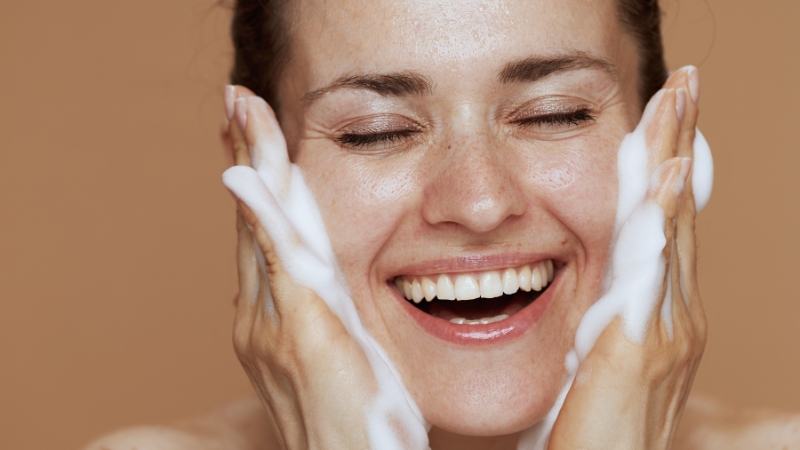
Share Post:
Skincare can sometimes feel like a bit of a puzzle, right? One day, your skin’s all dry and flaky, and the next, it’s shiny and oily—you’re left wondering if you need some kind of skincare GPS to figure it out. It can get pretty frustrating, especially when no matter how many products you try, things still don’t seem to balance out.
But here’s the thing: what if it’s not your skin acting up but the products you’re using? In this guide, we’ll take a look at how your routine might actually be contributing to those dry and oily skin issues.
The Basics of Skin Types
Before we can address the impact of various products, it’s essential to understand the different skin types and what causes them.
| Skin Type | Characteristics | Common Issues | Care Tips |
| Dry | Lack of moisture, tightness, flakiness, rough texture. Prone to redness and irritation. | Compromised skin barrier, sensitivity, and discomfort. | Use intensive hydration products; opt for creams with emollients like hyaluronic acid and squalane. Protect from environmental factors and avoid harsh cleansers. |
| Oily | Excess sebum production, shiny and greasy appearance, enlarged pores. | Frequent breakouts, clogged pores, and excessive shine. | Use products that balance oil production without over-drying; opt for gel-based or oil-free moisturizers. Incorporate exfoliants like salicylic acid to manage oil and prevent acne. |
| Combination | Features both oily and dry areas, typically an oily T-zone and dry or normal cheeks. | Difficulty in finding products that suit all areas, imbalance between oily and dry zones. | Use products that cater to both skin needs; consider gel-based moisturizers and targeted treatments. Balance exfoliation and hydration to maintain overall health. |
| Normal | Well-balanced, neither too oily nor too dry, generally free from blemishes or sensitivity. | Occasional minor issues; generally stable. | Maintain a balanced routine with a gentle cleanser, a moderate moisturizer, and regular sun protection. Adapt to seasonal changes or any minor skin changes. |
How Products Affect Your Skin
The ingredients in the products play a significant role in how they affect your skin. Here’s a breakdown of common ingredients and their effects: Cleansers:
- Foaming Cleansers: Often contain surfactants like sodium lauryl sulfate, which can strip natural oils from your skin. While effective for removing excess oil and impurities, they can leave dry skin feeling even more parched and uncomfortable. For oily skin, these can help reduce shine but might still need a follow-up hydrating step to avoid over-drying.
- Cream or Oil-Based Cleansers: These are formulated to gently dissolve makeup and impurities while providing hydration. They often contain emollients like oils or butters, which can help restore moisture. However, they may feel too heavy on oily skin, potentially leading to clogged pores or a greasy residue.
Exfoliants:
- Physical Exfoliants: These include scrubs with beads or grains that manually slough off dead skin cells. While effective for smoothing the skin’s surface, they can cause micro-tears if used too aggressively, leading to irritation and increased sensitivity in dry skin. For oily skin, excessive use can exacerbate oiliness and cause more breakouts.
- Chemical Exfoliants: Ingredients like alpha hydroxy acids (AHAs) or beta hydroxy acids (BHAs) break down dead cells and promote cell turnover. They offer a gentler alternative to physical exfoliants but can still cause irritation or dryness if overused. BHAs, in particular, are beneficial for oily skin as they penetrate and help clear clogged pores.
Moisturizers:
- Heavy Creams: These are often rich in emollients and occlusive agents, which help lock in moisture and create a protective barrier. They are ideal for dry skin that needs extra hydration but can feel greasy and potentially clog pores on oily skin, leading to breakouts. Choosing a non-comedogenic heavy cream can help mitigate these issues.
- Gel-Based Moisturizers: These contain water or gel-based ingredients that hydrate without adding excess oil. They are particularly suitable for oily or combination skin as they provide hydration without contributing to an oily shine. However, they may not provide enough moisture for very dry skin types, which might require additional layers or different formulations.
Sunscreens:
- Chemical Sunscreens: These use chemical filters to absorb UV radiation and are often lightweight and fast-absorbing. While they can be great for daily use without feeling heavy, they might irritate sensitive skin or cause reactions in some individuals. Ensuring they are fragrance-free and suitable for your skin type can help reduce these issues.
- Physical (Mineral) Sunscreens: These use physical blockers like zinc oxide or titanium dioxide to reflect UV rays. They tend to be thicker and can sometimes leave a white cast on the skin but are less likely to irritate or cause breakouts. They are especially beneficial for sensitive or dry skin types but may feel too heavy for oily skin.
The Role of pH Balance
Your skin has a natural pH level, typically around 4.5 to 5.5. Products with a high pH (alkaline) can disrupt this balance, leading to dryness or oiliness. Similarly, overly acidic products can cause irritation and compromise the skin’s protective barrier.
Maintaining a balanced pH helps keep the barrier’s function intact, reducing the risk of dryness and excessive oil production.
Using too many products or layering them incorrectly can also create issues. For example, combining multiple exfoliants or active ingredients like retinoids and acids can overwhelm your skin, leading to dryness or irritation. It’s essential to introduce new products gradually and avoid overloading your skin with too many active ingredients at once.
Common Problematic Products
If you suspect your products are causing your issues, it’s time to investigate.
Overly Harsh Cleansers
If your cleanser leaves your skin feeling tight and dry, it might be too harsh. Cleansers that strip away too much natural oil can lead to increased dryness or even trigger more oil production as the skin tries to compensate. Opting for a milder cleanser can help maintain its natural moisture balance.
Overuse of Exfoliants
Regular exfoliation is necessary, but overdoing it can lead to damage. Over-exfoliation can strip away essential oils and disrupt the skin’s barrier, resulting in redness, irritation, and increased sensitivity. Aim for 2-3 times a week and choose exfoliants appropriate for your skin type to avoid these issues.
Inappropriate Moisturizers
Using a heavy cream on oily skin can lead to breakouts, while a lightweight gel might not provide enough hydration for dry skin. Finding a moisturizer that fits your type is crucial; for instance, opting for oil-free moisturizers for oily skin and richer creams for dry skin can help maintain balance.
Incompatible Sunscreens
If your sunscreen feels greasy or causes breakouts, try switching to a different formulation. Mineral-based sunscreens might be a better option for sensitive skin types, while gel-based or powder sunscreens can provide a less oily finish for those with oily skin.
How to Find the Right Products
Finding the right products for your skin is key to getting that perfect balance and tackling any issues you might have. Depending on your type, consider the following:
For Dry Skin
Finding the right products for dry skin is crucial to ensure that your complexion remains hydrated, smooth, and comfortable throughout the day.
| Product Type | Recommended Ingredients | Avoid | Benefits |
| Hydrating Cleansers | Hyaluronic acid, Glycerin | Sulfates | Attract and retain moisture; avoid stripping natural oils |
| Rich Moisturizers | Ceramides, Hyaluronic acid, Squalane | / | Replenish and lock in moisture; creates a barrier to prevent water loss |
| Gentle Exfoliants | Enzyme-based, Lactic acid | Abrasive physical scrubs | Gently dissolve dead cells; improve texture without irritation |
| Hydrating Sunscreens | Hyaluronic acid, Glycerin | / | Provides hydration while protecting against UV damage; non-comedogenic options avoid clogged pores |
For Oily Skin
Managing oily skin can be a balancing act between controlling excess shine and maintaining adequate hydration, but the right products can make all the difference in achieving a fresh, clear complexion.
| Product Type | Recommended Ingredients | Avoid | Key Benefits |
| Cleansers | Foaming or gel-based cleansers with salicylic acid or benzoyl peroxide | Creamy cleansers | Controls excess oil, prevents breakouts, reduces shine without over-drying |
| Moisturizers | Gel-based or oil-free moisturizers labeled as non-comedogenic | Heavy, greasy creams | Provides hydration without excess oil, prevents clogged pores, balances oil production |
| Exfoliants | Chemical exfoliants with BHAs like salicylic acid, used 2-3 times a week | Over-exfoliation | Clears out excess sebum, manages oiliness, prevents breakouts |
| Sunscreens | Gel-based or powder sunscreens designed for oily or acne-prone skin | Sunscreens that are greasy or heavy | Provides sun protection with a matte finish, controls shine |
For Combination Skin
Combination skin can be challenging, as it requires a balanced approach to manage both oily and dry areas effectively.
| Product Type | Recommended Ingredients | Key Features |
| Dual-Purpose Cleansers | Gentle foaming agents, balancing surfactants, hydrating ingredients like glycerin or hyaluronic acid. | – Removes excess oil from T-zone – Maintains moisture in drier areas – Formulas suited for mixed skin types |
| Balanced Moisturizers | Lightweight, non-comedogenic ingredients like dimethicone, hyaluronic acid, or squalane. | – Works across different areas of the face – Gel-cream texture often effective – Hydrates and controls oil |
| Selective Exfoliation | Physical exfoliants (like silica or jojoba beads) and chemical exfoliants (like salicylic acid or lactic acid). | – Exfoliate oily areas more frequently – Gentle on drier areas – Maintains even texture and prevents buildup |
| Versatile Sunscreens | Broad-spectrum filters (like zinc oxide or titanium dioxide), lightweight moisturizers (like glycerin or aloe). | – Provides sun protection – Controls shine in oily areas – Moisturizes dry spots – Lightweight and non-greasy |
Wrapping It Up
Good skincare isn’t about buying the most expensive products or following trends. It’s about knowing what your skin needs and finding what works for you. If you’re having skin problems, try looking at the products you’re using—they might be what’s missing to help your skin look its best.
Related Posts:
- 14 Skin Care Products That Should Never Be Refrigerated
- Are Tanning Oils Safe? What It Does to Your Skin…
- How Life's Challenges Accelerate Skin Aging and How…
- Secrets to Glowing Skin with Just Primer and Setting Spray
- How to Achieve Smooth Skin on Your Legs Naturally -…
- 8 Reasons Why Red Wine Could Be Your Secret to Glowing Skin










